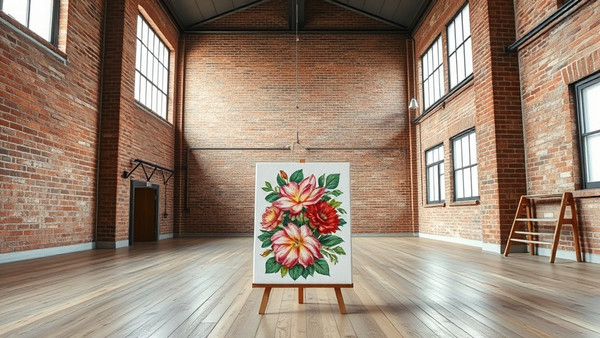Get It Right: How Big Should Your Canvas Art Be?
Posted by MintSuper Art on 20th Dec 2024
The size of a canvas can quietly shape the mood of a room, though it’s something people might not think about right away. A massive piece can dominate, making the space feel smaller, almost suffocating. On the flip side, a tiny canvas might seem like an afterthought, swallowed by the wall around it.
Finding the right balance—where the artwork feels like it belongs—isn’t always simple. It’s not just about measurements; it’s about how the art interacts with the space. So, how do you figure it out? Keep reading for tips to choose a canvas size that fits just right.
Key Takeaway
- The size of your canvas art should match the room size.
- Larger art makes a bold statement, while smaller art adds subtlety.
- Always measure your wall space before buying.
General Rules for Sizing Canvas Prints
A common question is how big a canvas should be for a given wall. While personal preference plays a role, standard guidelines help: large canvases often suit spacious walls, while smaller works accent narrow areas or gallery walls. Scaling your canvas correctly creates visual flow and avoids awkward blank spaces. For tips on specific placements, our article on how to pick the right canvas print for your space shares advice tailored for different types of rooms.
How to Choose the Right Canvas Size for Your Walls
Measure Your Wall Space
The first thing to do is measure the wall. Knowing how much space you’ve got makes everything easier. A simple rule is to leave some empty space around the canvas. This helps the art stand out instead of looking squished. For example, if your wall is 60 inches wide, a canvas around 36 inches wide works well. That leaves space on both sides, which feels balanced.
Grab a measuring tape (or borrow one if you don’t have one). Measure the height and width of the wall. Then think about the furniture nearby. If the canvas is going above a couch or table, it shouldn’t be too big or too small. A huge canvas over a small couch might make the couch seem tiny. But a tiny canvas over a big couch? It might just disappear.
Here’s a trick: use painter’s tape to outline the canvas size on the wall. It’s like testing before committing. You’ll get a better idea of how it’ll look without guessing.
Think About the Room Size
The size of the room matters just as much as the wall. Big rooms can handle big canvases, like 36x48 inches. They make a statement and fill the space. But in a small room, that same canvas might feel like it’s taking over. [1] Smaller canvases, like 8x10 inches, usually fit better in tighter spaces.
Think about what the room is for. A living room might need something bold and eye-catching. A bedroom, though, might feel better with smaller, softer pieces.
Also, don’t forget about how high to hang the canvas. If it’s too high, people might have to crane their necks to see it. Hanging it at eye level is usually the way to go. For most people, that means the center of the canvas should be about 57 to 60 inches from the floor.
If you’re still unsure, step back and look at the wall. Imagine the art there. Does it feel right? Trust your gut—it’s usually spot on.
Consider the Viewing Distance
Credits: Ballard Designs
When thinking about art, it’s good to think about how far away people will stand to look at it. For a big canvas, people might step back to take it all in. That works well for bold, eye-catching pieces. But for smaller art, it’s better when people can get up close, like in a cozy corner or a quiet reading nook. What kind of feeling should the art give when someone sees it?
The size of the artwork can really change how a room feels. Big pieces? They’re dramatic. They grab attention from across the room. And if someone has to walk closer to see little details, that can spark curiosity.
Smaller pieces, though, are great for more personal spaces. They let people enjoy the details up close. So, it’s worth asking—how should visitors experience the art in your space?
Standard Canvas Sizes
Common Sizes for Different Purposes
There are a lot of canvas sizes to pick from. Here are some of the most common ones and what they’re usually used for:
| Size Category | Dimensions (inches) | Typical Uses |
| Mini Canvases | 5x5, 6x6 | Small accents or group displays |
| Small Canvases | 8x10, 11x14 | Perfect for intimate spaces |
| Medium Canvases | 16x20, 20x24 | Versatile for all kinds of subjects |
| Large Canvases | 24x30, 24x36 | Bold statements |
| Extra-Large Canvases | 36x48, 40x60 | Dramatic focal points in big spaces |
These sizes make it easier to find the right fit for a home. Is there one that stands out?
Mini canvases are small but charming. You can put them almost anywhere, or group a few together for a creative display. Small canvases? They’re great for desks, shelves, or little nooks. Medium canvases fit nicely in hallways or above furniture. Large canvases demand attention—they can even be the centerpiece of a room. And extra-large canvases? They’re bold and perfect for open spaces, like a big living room or loft.
Picking the right size isn’t just about the space you have. It’s also about what feels right. What kind of vibe do you want the art to bring into your home?
Artistic Style and Subject Matter
Choose Based on Art Type

Different types of art shine at different sizes. Abstract art, for example, often looks its best when it’s big—like 36x48 inches or even larger. The extra space lets the colors and shapes spread out, giving them room to "breathe" (so to speak). Portraits, though, are a bit different. Medium sizes, like 18x24 inches, tend to work better. They’re big enough to show details but not so large that they feel overwhelming.
So, what kind of art is it? That’s the first thing to think about. The size of the piece can really change how it feels in a space. Some styles—like bold, abstract works—need more room to make an impact. Others, like delicate watercolors or detailed drawings, are better appreciated up close.
Take a big landscape painting, for instance. If it’s large, it can fill a wall and create a calm, peaceful vibe in a living room. On the other hand, a small watercolor might be perfect for a little nook or reading corner. It pulls you in, inviting you to take a closer look at all the tiny details.
Display Intentions
Gallery Wall or Single Piece
If the plan is to create a gallery wall, the size of each piece matters a lot. Small canvases grouped together can create a neat, cohesive look. But if it’s just one large piece, it can stand out as the star of the room. [2] So, what’s the goal? What’s the art supposed to say about the space?
For a gallery wall, mixing sizes can make it more interesting. A mix of small, medium, and even a few larger pieces can create a fun, lively display. Using different frames can add even more personality. But it’s important not to overdo it—leave some space between the pieces so the wall doesn’t feel too crowded.
Now, if it’s a single large canvas, that’s a whole different vibe. A big piece can make a bold statement, especially in a living room or above a fireplace. It grabs attention and can even become a conversation starter. It’s like the room’s centerpiece, drawing the eye right to it.
Whether it’s a gallery wall or a single piece, the size and placement of the art can change the whole feel of a room. It’s worth taking a little time to think it through.
Budget Considerations
Costs of Canvas Sizes

Money matters when it comes to art. Bigger canvases usually cost more—not just for the artwork itself but also for the frame. Smaller canvases? They’re often cheaper and might be a smart pick for anyone watching their wallet. It’s always a good idea to think ahead. How much do you want to spend?
When checking prices, it’s worth remembering all the extra costs. There’s the canvas, of course, but also shipping and framing. Big pieces can get pricey. They might need special frames or mounts, which adds up.
Smaller pieces, though, can still pack a punch. They’re often less expensive and give more room to play around. A mix of small pieces can look amazing together without costing too much.
Having a budget in mind makes decisions easier. It can even make the whole process more fun.
FAQ
How do I choose wall art size based on my wall space?
When selecting wall art size, measure your empty wall space first. A general rule is that wall art should take up 60-75% of the available wall space, particularly over piece of furniture. For instance, art above a couch should be roughly 2/3 the width of the couch. Consider whether you want a statement piece or multiple pieces for visual interest.
What's the ideal canvas size for different rooms like dining room and living rooms?
For living rooms, large wall art typically works well as a focal point - think 3-4 feet wide for statement pieces. In dining rooms, medium canvas sizes about 24-36 inches wide are a popular choice. Remember to consider the room's scale and existing wall decor when choosing art sizes.
What are common canvas prints and wall art sizes available?
Canvas prints and wall art come in standard sizes from mini canvas (8x10") to extra large (48x60"). Square canvases are popular for modern looks, while oblong canvases work traditionally. Popular canvas sizes include 16x20", 24x36", and 36x48". For high quality results, make sure your image size matches your desired print size.
How do different types of art affect sizing decisions?
Whether you're choosing fine art, digital art, or metal prints, sizing matters. Art canvas typically needs more wall space than framed prints due to their depth. Cotton canvas works best in larger sizes to show texture, while art prints and framed print options are more flexible for small canvas to sized canvases arrangements.
What's the best approach for hanging wall art in different spaces?
The aspect ratio of your wall art should complement your interior design. For blank wall areas, consider canvas wall art arrangements using multiple sized pieces. A popular wall art approach is hanging art at eye level, about 57-60 inches from the floor. Remember to leave breathing room around your wall art ideas.
Conclusion
Figuring out the right size for canvas art isn’t as tricky as it seems. Measure your wall, think about how far you'll be standing from it, and don’t forget your budget. A smaller room might need a 16x20, while a big space could handle a 36x48. Also, match the art style to your vibe—modern, abstract, or classic. Just take your time, and you’ll end up with something that feels like it belongs.
References
- https://bruzzen.com/canvas-sizes-guide/
- https://vybeinterior.com/blogs/art-recommendations...

